The Consequences will be fearful: The Great Famine in County Donegal

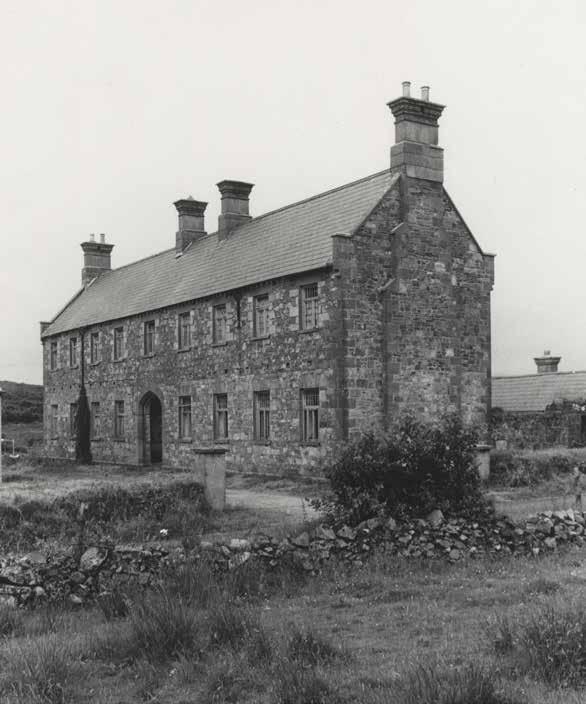
County Archives & Museum, Donegal County Council Essays
Donegal
in Residence
by Dr Hilary McLaughlin-Stonham, Historian
Front Cover Image 1: Minutes of meeting of Milford Board of Guardians, 7 December 1846
Front Cover Image 2: Milford Workhouse Fever Hospital (Photograph Courtesy of Irish Architectural Archive)
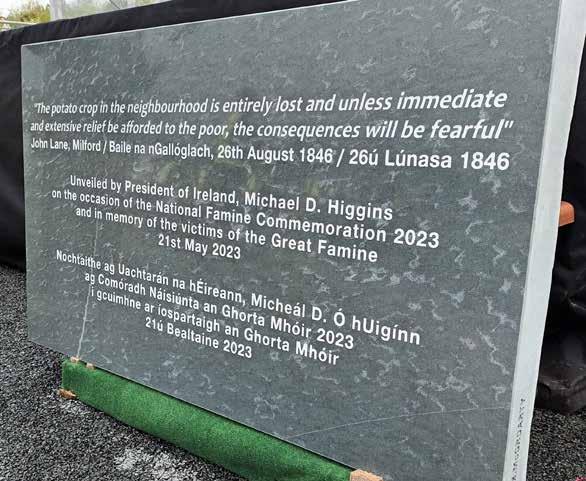
Above:
The commemorative stone commissioned from Michael McGroarty, for the National Famine Commemoration, held in Milford, 21st May 2023.
ISBN: 978-1-915111-03-6
3 Essays by Dr Hilary McLaughlin-Stonham, Historian in Residence | Contents Acknowledgements 4 Foreword 5 Introduction 7 The Impact of the Great Famine in County Donegal 9 Life and Death in Letterkenny during the Great Famine 16 Inishowen Workhouse in a time of crisis 24 Emigration: Farewells and Beginnings 32 References 40
The Consequences will be fearful: The Great Famine in County Donegal
Acknowledgements
Donegal County Archives and County Museum, Donegal County Council, would like to thank Dr Hilary McLaughlin-Stonham, our Historian in Residence for the Great Famine National Commemoration 2023, for all her work in researching and writing this book of essays.
Donegal County Council and Dr Hilary McLaughlin-Stonham wish to thank the following for their support and access to sources on the subject of the Great Famine in County Donegal: the Culture Division of Donegal County Council, Public Record Office of Northern Ireland, Mellon Centre for Migration Studies, Derry City and Strabane District Council Museum and Archives Service, National Library and National Archives of Ireland.
Donegal County Council would also like to acknowledge the support of the Department of Tourism, Culture, Arts, Gaeltacht, Sport and Media.
4
|
Foreword
County Donegal had the honour of hosting the National Famine Commemoration on 21st May 2023. This gave our county a unique opportunity to acknowledge and highlight the suffering endured by the Irish people and especially the people of Donegal during those terrible years from 1845 to the early 1850s. The Culture Division of Donegal County Council led out on the organisation of this deeply poignant national event, held on the site of the former Milford workhouse, in cooperation with the Department of Tourism, Culture, Arts, Gaeltacht, Sport & Media and the OPW and with the assistance of the Garda and the Defence Forces.
The National Commemoration was addressed by President Michael D. Higgins who paid tribute to those who suffered or perished in the Famine, throughout Ireland and particularly in County Donegal. The Government was represented by Jack Chambers, Minister of State at the Department of Transport & Department of the Environment, Climate & Communications.
It was appropriate that the event took place on the former site of the Milford workhouse, itself a symbol of the death, loss and grief of the people of Donegal during the years of the Great Famine. The workhouse was often a last resort for many destitute, starving, or homeless individuals and families and often the place from which many emigrated, never to return.
The commemorative stone commissioned especially for the National Commemoration, with its devastating quote from a member of Milford Relief Committee, serves as a moving memorial to the people who lost their lives, were bereaved, evicted or were forced to emigrate during the Famine years.
5 Essays by Dr Hilary McLaughlin-Stonham, Historian in Residence |
The Consequences will be fearful: The Great Famine in County Donegal
Donegal County Council’s Culture Division would like to thank Dr Hilary McLaughlin-Stonham for her work as Historian in Residence in 2023 which has resulted in this book of deeply researched scholarly essays on various aspects of the Great Famine as it affected County Donegal.

Martin Harley
An Cathaoirleach
Donegal County Council
6
Introduction
The 2023 National Famine Commemoration in Milford, County Donegal took place on the former site of the Milford workhouse. This booklet of essays was commissioned to commemorate that event and in memory of those who suffered during the Great Famine and those who fled to create new lives abroad. The event has provided fresh opportunities for investigation into the Great Famine in Donegal and how it shaped and influenced the lives from birth to death of local people.
This booklet of essays draws on the physical and online records that are available from the period to consult at Donegal County Archives. Together with sources from the National Archives, the Public Record Office of Northern Ireland, the Mellon Centre for Migration Studies, newspapers and other sources, the story of the Famine emerges through the people that experienced and recorded it.
The first essay looks at the outbreak of famine across Donegal while the subsequent essays focus on themes of life and death in a town, and experiences of the workhouse and those that emigrated. Letterkenny is used to demonstrate the experience of one town in the county and ways in which people reacted to the catastrophe, altering their routine and life during the crisis. It draws on sources such as letters from the Famine Relief Commission, the Letterkenny workhouse minutes and travel writers of the period. The second essay focusing on Inishowen workhouse illustrates how one workhouse coped during the Famine and how this ultimately translated to the experience of inmates. It draws on diaries, workhouse registers and minutes as well as reports by newspapers to outline the complex balance of necessity and order that was deemed necessary in the chaos of the Great Famine.
7
by Dr
Historian in Residence
Essays
Hilary McLaughlin-Stonham,
|
The Consequences will be fearful: The Great Famine in County Donegal
The final essay uses ship registers, dispatches from Emigration Commissioners to Colonial Offices and letters from immigrants themselves to provide a snapshot of the risks and opportunities involved in emigrating from Donegal.
It is hoped that this book of essays will provide the public with insight into the rich avenue of sources available in the County Archives and beyond and encourage them to pursue their own interest in the Great Famine in Donegal.

Dr Hilary McLaughlin- Stonham Historian in Residence (The Great Famine), Donegal County Council
8
The impact of the Great Famine in County Donegal
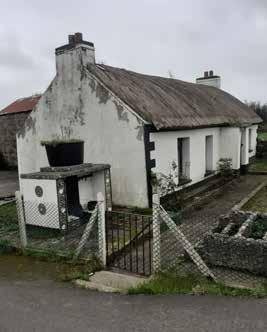
The Great Famine 1845 to 1851 was a catastrophic event that continues to evoke powerful emotions nationally. In Donegal the Famine endures in the local consciousness, its footprint on the county inescapable among the Brachán houses and famine graveyards that punctuate the landscape. The impact of the Famine was widespread in Donegal with the loss of forty thousand people to death and emigration.1 The effects were felt immediately. Families of small farmers and labourers comprised the greater portion of the county. As tenants living on yearly potato crops they witnessed the breakdown of their communities. Death and dearth overwhelmed the populations’ ability to cope with the crop failure and the stark choice that remained for many was starvation, workhouse relief or emigration.
(Image: Hilary McLaughlin-Stonham)
1 Department of Industry and Commerce, Population of Saorstát Éireann from 1821 to 1936 (Dublin: Stationary Office:1938), 6.
9 Essays by Dr Hilary McLaughlin-Stonham, Historian in Residence
|
Brachán house, Carndonagh. Indian meal was distributed to people from there.
The Consequences will be fearful: The Great Famine in County Donegal
Donegal entered the famine years with a population of almost 300,000, the inhabitants largely dependent on their own agricultural labour. Women outnumbered men in this predominantly rural society though men tended to have higher literacy levels, an indication that girls were often kept at home.2 The number of houses in each area closely reflected the number of families living in the county though over 2,500 families either shared with extended family or found alternative shelter.3 Houses, graded by census enumerators in 1841, ranged from affluent class one to a poor class four, consisting of mud walls, ‘having only one room and window.4 These small vernacular cottages housed the largest portion of families in the county with hundreds of larger, third-class cottages housing two, and in some areas, three families.5 Travellers to Donegal described these cottages as “rude huts of loose stone or turf” and as the Famine progressed homes were described as “dark, smoky, floorless abodes”.6 Small farmers in Stranorlar, with a few acres, were purported as living in “miserable hovels in a state of degradation…often without window or chimney”.7 Half of the population of Donegal were described as living entirely off their potato crop prior to the Famine with the more comfortable supplementing it with oatmeal.8 Pre-famine scarcity already existed in the summer months when the old crop was used and the new crop was yet to be harvested.9 As a result the impact of the potato failure was immediate.
2 The actual number for Donegal was 296448 persons. See: Irish Census Commissioners. Irish Census report 1841 (Dublin: Alexander Thom:1843), 306-314.
3 Ibid.
4 Robert E. Matheson, “The housing of the people of Ireland during the period 1841-1901” Journal of the Statistical and Social Inquiry Society of Ireland 11, no 83 (1902/1903): 197.
5 Commissioners, Irish Census report 1841, 312-313.
6 Asenath H. Nicholson, Annals of the Famine in Ireland, in 1847, 1848, and 1849 (French: New York, 1851) 85, 102.
7 The Society of Friends, Transactions of the Central Relief Committee of the Society of Friends During the Famine in Ireland 1846 and 1847 (Hodges and Smith: Dublin, 1852) 147, 148.
8 Ibid. 147.
9 Annual Report of the Commissioners for Administrating the Laws for Relief of the Poor in Ireland (Alexander Thom: Dublin, 1843) 58.
10
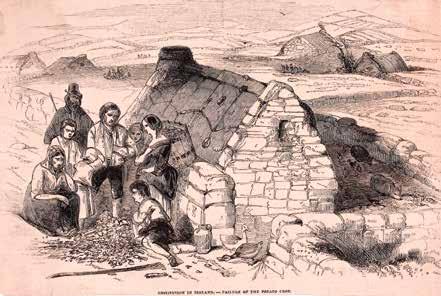
Illustration from “Pictorial Times”, 22nd August 1846, depicting a family outside their cottage, gathered around a pile of ruined potatoes.
(Image courtesy of the National Library of Ireland)
As early as December 1846, small farmers in Dunfanaghy had exchanged or sold their pigs, bedclothes, fowl and fishing nets in order to buy food which was quickly used up. Families were described as living off one meal of cabbage or seaweed soup per day while others substituted their diet with watery thin oatmeal gruel. In many areas no public works projects were available as a means to buy food.10 Government public works schemes, on roads and improvements, began in 1846 but were scattered projects. Charities such as the Society of Friends and American fundraisers established work relief projects. Loans were also provided, such as that extended to a Dungloe Kelp manufacturer, to provide employment for the destitute. This project failed within the year and in 1847 little of the funds were returned. Throughout Donegal, support for tenants from landlords was inconsistent. On some absentee landlord estates, in the west of 10 The
11
Essays
by Dr Hilary McLaughlin-Stonham, Historian in Residence
Society of Friends, Transactions, 148.
The Consequences will be fearful: The Great Famine in County Donegal
the county, tenants were witnessed to be in a state of starvation.11 In the Northwest, the Culdaff Relief Committee complained in 1847 that there were few resident gentry capable of “affording relief to the numerous, and daily increasing, famishing population”, and of the mere 136 people employed on public works when there was need for over 2,000.12
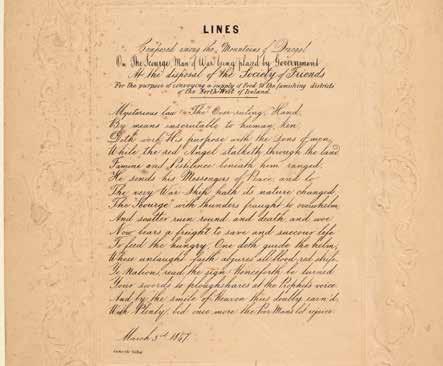
Lines Composed Among the Mountains of Donegal on the Scourge, Man of War Being Placed By Government At the Disposal of the Society of Friends. S.l.: Lemonts lithographers, 1847.
(Image courtesy of the National Library of Ireland)
On some large estates, there was toleration for rent arrears at the beginning of the Famine, a concession which would decline by 1851-2. On the Stewart Murray estate in southwest Donegal, the 1846 rental payments were sporadic with a greater proportion of
11 Ibid. 147.
12 Brook Young, Letter, Famine Relief Commission: Incoming Letters, 22 February 1847.
12
tenants in arrears. In parishes within Killybegs, the pressure to pay rent and the heavy debt of arrears meant that some tenants simply ‘ran away’ with arrears ‘lost’. Rents were also ‘lost’ when tenants became ‘paupers in the Union’ or through emigration.13 The Kildea family, in arrears in 1846, were still present on the rental records of 1851-2 and despite debt, managed to hold onto their tenancy throughout the Famine. By the 1850s rent payments were more constant with noted evictions, and tenants continuing to immigrate to America, leaving the debt behind.14 The phrase ‘arrears lost’ implies that both landlord and tenant saw emigration as permanent, and an escape from soup kitchens or the workhouse.
The workhouses were built as a result of the 1838 Poor Relief Act in districts known as ‘Unions’. Between 1843 and 1846, workhouses opened in Donegal Town, Glenties, Stranorlar, Dunfanaghy, Inishowen, Letterkenny, Ballyshannon and Milford. Funded by the poor rate, Unions supported the workhouses and as the Famine progressed, outdoor relief in the form of soup kitchens. Designed for between 300 and 600 paupers, they exceeded this as the lack of food and the ability to afford meal or grain overtook the population. In larger institutions in Glenties and Ballyshannon, conditions in 1846 were described as being in ‘a dreadful state; the people were in fact half-starved and only half clothed.’15
Workhouses with less capacity, such as Milford which could house 400 paupers, also saw resources stretched and conditions deteriorate. When it opened in 1846 the only foods ordered for the inmates were oatmeal, bread, potatoes, sweet milk, and buttermilk. However, there were no complaints from paupers except for the lack of tobacco.16 By 1847 grievances by inmates included a lack of provisions and
13 The Trustees of Horatio Granville Steward Murray Esq. 1846, Murray Stewart South Donegal estate survey and rentals, 1749, 1846 – 1905.
14 Note: Kildea is spelt Gildea by 1852 in the rental record.; Murray Scarborough Receivers 7th Account Book, 1852, Murray Stewart Collection. 3, 5, 7, 16, 21,22, 26, 48.
15 The Society of Friends, Transactions, 150.
16 Milford Board of Guardians (1847), Report of Visiting Committee 1846-1912, 2-4.; Milford Board of Guardians (1848), Minutes 1840-1923, 399.
13 Essays by Dr Hilary McLaughlin-Stonham, Historian in Residence
The Consequences will be fearful: The Great Famine in County Donegal
‘bad’ treatment but were dismissed as ‘trivial complaints’. As famine conditions heightened in 1847, the workhouse was described as in ‘a slovenly condition in every department’ with the clothing supplied to paupers ‘in a dilapidated condition’.17 In April 1847 the Board of Guardians considered refusing admission to more paupers than the building was constructed to accommodate. However, by May they described the pressure on the workhouse ‘which now contains fifty over what it was originally intended for…’.18 Two inquests held that year into deaths at Milford workhouse found a verdict of death from want.19 Outbreaks of fever, dysentery and even measles alongside the required separation of families in wards, meant that many from the local Milford area applied for outdoor relief. In April 1848 those relieved outdoors in Milford far exceeded those in the workhouse where numbers stayed below capacity.20 Workhouse Commissioners recognised the reluctance of many to enter the workhouse but ignored the conditions of entry, arguing that the actions of those who starved rather than enter the workhouse were to be ‘deplored.’21 In 1849 Mary Coll applied for a pass for herself and two of her four children to visit her house and determine if her home was still viable. She was to be readmitted if her house was uninhabitable.22
The loss of tenancy and home would have a profound effect on the population with the number of unmarried men and women aged above forty increasing from 1841 to 1851, a pattern that would continue well into the next century in rural areas and influence emigration.23
17 Board of Guardians (1847), Report of Visiting, 6,10.
18 Milford Board of Guardians (1848), Minutes 1840-1923, 117, 150.
19 Annual Report of the Commissioners for Administrating the Laws for Relief of the Poor in Ireland (Alexander Thom: Dublin, 1848) 214.
20 Ibid.
21 Ibid. 17.
22 Milford Board of Guardians (1849), Minutes 1840-1923, 26.
23 J.P Kent, “On the Decline of Marriage in Rural Ireland 1851-1911: The Role of Ecological Constraints and/or Developing Philopatry” Population and Environment 23, no. 6 (2002): 525–40.
14
Pre-famine, the Poor Law Commissioners saw emigration as desirable especially for female inmates for domestic labour and as wives.24 As the Famine progressed, orphaned girls from the workhouses were selected for government sponsored emigration schemes led by the Secretary of State for the Colonies, Earl Grey.25 Fifteen-year-old Sally Gillon from Donegal town arrived in Melbourne on the Lady Kennaway in 1848 and worked as a nursemaid. The Donegal Union had advanced her 12 shillings for a cloak which they expected to be reimbursed for. Fourteen-year-old Catherine Baird from Letterkenny also sailed on the Lady Kennaway and was employed as a house servant. She later married a ships steward in Bendigo in 1872 and was joined by her niece from Donegal in 1865.26 Often whole families emigrated, and mortality was high on emigration ships due to the poor condition of both emigrants and the ships. Donegal emigrants Eliza Farren, Andrew Elliot and James Johnson are recorded as dying at Grosse Ile, Canada, while waiting for the ship to pass quarantine. Other emigrants were shipped in similar conditions to America and Canada such as those on the McCorkell and J & J Cooke shipping lines from Derry. Others did not make it beyond Britain, at times exchanging a Donegal workhouse for one at Liverpool and dying within days of being admitted.27
In 1851, as the potato crops began to recover, 4,865 people emigrated from Donegal. 28 The experiences of small farmers, workhouse residents and emigrants provide a synopsis of the impact of the Famine in Donegal. The loss of home, overwhelming rental debt and dearth would drive many to the newly constructed workhouses and set a pattern of emigration that would continue into the next century.
24 Annual Report of the Commissioners 1843, 60.
25 Annual Report of the Commissioners 1848, 150-156.
26 Irish Famine Memorial Sydney. Orphan Data Base.
27 Liverpool Workhouse Admissions, November 1846-March 1848. Liverpool Records Office: May 5th, 1847.
28 Sean Beattie, Donegal in Transition: The Impact of the Congested District Boards, (Irish Academic Press: Kildare, 2013) 55.
15 Essays by Dr Hilary McLaughlin-Stonham, Historian in Residence
Life and Death in Letterkenny during the Great Famine
The failure of the potato crops in townlands across Donegal saw poverty and destitution among many families increase dramatically after 1845. Letterkenny, the largest town in the county, was no exception. Within the town, men, women and children sought relief from hunger through the workhouse, outdoor relief, and emigration. Women were often more vulnerable and children experienced destitution, a lack of protection and the harshness that often accompanied government relief. For others, elevated social and economic positions prior to the Great Famine led to positions of authority overseeing the crisis, thus cushioning their exposure to the effects of famine. These occurrences illuminate the personal experiences that placed townspeople within the challenging conditions of life in Letterkenny between 1845 and 1851.
In 1841 Letterkenny was recorded as a town of 66 acres in the Barony of Kilmacrenan with a population of 2,161.1 Letterkenny Poor Law Union was divided into 14 electoral divisions with the workhouse based in the town. There were 20 first class houses in the town, the most in any one area of the barony. The number of poorer houses almost equalled that of the more prosperous, indicating this was a town of two halves, the poor and the affluent.2 Occupations within the town reflected this
1 Unlike other areas of Donegal with a growing population, Letterkenny’s population had decreased by several hundred in twenty years but had remined steady since 1831. There have been some concerns by various academics on the ‘dubious value’ of the 1821 and 1831 census records. See: Cormac Ó Gráda, “The Population of Ireland 1700-1900: A Survey”, Annales de Démographie Historique, (1979): 282-283.
2 Irish Census Commissioners. Irish Census report 1841 (Dublin: Alexander Thom, 1843), 306-307.; Robert E. Matheson, “The housing of the people of Ireland during the period 1841-1901” Journal of the Statistical and Social Inquiry Society of Ireland 11, no 83 (1902/1903): 197.
16 The Consequences will be fearful: The Great Famine in County Donegal |
with over double the number of workers employed in manufacturing and trade, such as food and clothing rather than agriculture. 3 There was also an Irish Constabulary barracks, a courthouse, a gaol, a national school and small fever hospital.4
In the late 1830s visitors described the Irish language as prevalent among the large numbers of poor and destitute who gathered for handouts of meal and potatoes from affluent townspeople. Local landlords held children’s Sunday scripture in their homes for tenants. Roman Catholic, Anglican and several Presbyterian churches in the town were well attended. Pre-famine Letterkenny was little more than one long street, thriving with merchants of woollen draperies, and spirit and grocery shops which supplied the whole eastern and northern parts of Donegal. Exports included corn, linen and flax which was grown in the surrounding areas.5
In 1845, initial reports by inspectors painted a poor picture of the potato crop, “… all through the Letterkenny district, a serious loss has taken place, the extent of which cannot at present be ascertained.”6 Despite this, the large Market, or ‘Margymore’ continued to be held in the town every Good Friday.7 Famine era residents of the town, particularly on Main Street, varied in wealth from small houses with offices valued at three pounds to larger grain merchants such as Matthew Wilson with property valued at eighteen pounds. To avoid losses during the Famine, Wilson contacted the Relief Commission in 1846 to inquire if the cost of grain was to be lowered in the area so that he might divert his recent imports of Indian corn, meant for the Letterkenny market,
3 Irish Census Commissioners. Irish Census report 1841 (Dublin: Alexander Thom, 1843), 306-307.
4 Samuel Lewis, A Topographical Dictionary of Ireland (London: Lewis & Co., 1837), 258.
5 Charlotte Elizabeth. Letters from Ireland MDCCCXXXVII (New York: John S. Taylor, 1843), 312-314.; Canon Maguire, Letterkenny Past and Present (Letterkenny: Old Seminary,1917), 1-38; Henry D. Inglis, A Journey Throughout Ireland during the Spring, Summer, and Autumn of 1834 (London: Whittaker & Co., 1838) 306-307.
6 Charles Hayden, Letter, Famine Relief Commission, 25 October 1845.
7 “Wanted”, Derry Journal 21 July 1840:3.; “Fairs in Ulster for the Current Week,” Derry Journal, 10 April 1838: 3.
17
Historian in Residence
Essays by Dr Hilary McLaughlin-Stonham,
The Consequences will be fearful: The Great Famine in County Donegal
to other areas.8 Wilson was not alone in standing apart from the poor. Although the resident town landlord, Lord Southwell, was considered well liked, other absent landlords were unpopular, with tenants living in extreme poverty with only potatoes and milk for subsistence when famine occurred. Landlords’ agents were also absent, appearing only in the neighbourhood to collect high rents.9 Rents could be supplemented with loans and the Letterkenny Loan Fund accounts indicated in the 1840s that “there is rather more than one loan to every family, or one loan to every five of the population”. Debt had consequences and the Loan Fund Society applied for 107 summonses and 89 warrants for the recovery of almost £200. 10
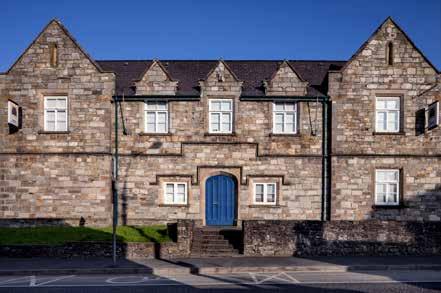
9 Henry D. Inglis, A Journey Throughout Ireland during the Spring, Summer, and Autumn of 1834 (London: Whittaker & Co., 1838) 306-307
10 Thomas Campbell Foster, Letters on the Condition of the People of Ireland (London: Chapman & Hall, 1846), 309, 312.
18
8 Ireland Valuation Office Field Book 4. County Donegal.; Matthew Wilson, Letter, Famine Relief Commission, 16 September 1846.
Donegal County Museum, part of which was formerly Letterkenny workhouse.
At the onset of the Famine, Letterkenny workhouse had been open a year and could accommodate 500 paupers. By August 1846 the potato crop in Letterkenny showed signs of disease in every electoral division and numbers in the workhouse increased dramatically. Pregnant women, children and older people were the most vulnerable during the Famine and children under ten accounted for 24% of the dead.11 Throughout 1846 over 300 people were admitted or born in Letterkenny workhouse while a further 124 were discharged or died.12 The absence of children was described by visitors travelling through Letterkenny in 1847 and children of all ages were vulnerable to destitution and lack of care. 13 James Marshall, an elected Guardian for the Union, moved that no children, deserted or not, be admitted to the workhouse until their parents’ names could be ascertained from the electoral division. No alternative was suggested for their intermediate care.14 However, vulnerable children were admitted a month later under referral of the Presbyterian Minister, Moses Houston. The Fadden family had experienced the death of their father Neil and their mother ‘lay idle’ with fever. Wary of the children contaminating the workhouse, the Board conceded to admit them to the fever hospital. Fortunately, the workhouse doctor declared them fit, and the children were not exposed to the distress of the sick, dying and fever. 15 Between the month of May and June 1847, when the workhouse was well above capacity with 4-6 weekly deaths, a child was born every week. Surprisingly, records show that no further children were born until well over a year later.16 Hunger within the workhouse itself was evident, and
11 Patricia Lysaght “Perspectives on Women during the Great Irish Famine from the Oral Tradition”, Béaloideas 64/65 (1996): 98.
12 Annual Report of the Commissioners for Administrating the Laws for Relief of the Poor in Ireland (Alexander Thom: Dublin, 1847) 182. Numbers of Ireland as a whole show the number of women and children far outnumber men in the workhouses. See: Annual Report of the Commissioners for Administrating the Laws for Relief of the Poor in Ireland (Alexander Thom: Dublin, 1850) 110.
13 Asenath H. Nicholson, Annals of the Famine in Ireland, in 1847, 1848, and 1849 (French: New York, 1851) 84.
14 Letterkenny Board of Guardians, Minutes 1841-1846, 421.
15 Ibid. 425, 431.
16 After 14 May 1847, records began distinguishing between those admitted and those born in the workhouse; Letterkenny Board of Guardians, Minutes 1847-1848, 97-205.
19 Essays by Dr Hilary McLaughlin-Stonham, Historian in Residence
The Consequences will be fearful: The Great Famine in County Donegal
paupers such as Nancy Doherty were punished, for having ‘pilfered’ meal while in the fever hospital.17
Outside of the workhouse, the local curate George Prior complained of the lack of cooperation between denominational leaders, referring in particular to the parish priest. He requested aid from the Relief Commission for at least 215 families in distress “of all denominations”.18 Observers of local priests in the area noted that some of the priests were very poor themselves and while some died working among the hungry, others looked “passively” on.19 Relief Committees were disorganised and Board of Works projects, which were particularly needed in Letterkenny, were requested immediately.20 By 1847 fever had gripped the area and the workhouse began to erect temporary sheds to accommodate 40 more fever patients which quickly filled above capacity. 21 The Letterkenny Relief Committee was organised the same year and was additionally funded by donations from local landlords such as John Stewart of Rockhill who donated £20. He would also act as Chairman of the committee.22 A 30-gallon tub was purchased in addition to buckets for the ‘stirabout’ which consisted of rice, Indian meal, pea meal and water. Tickets for rations were issued to feed at least 341 people a day.23 In 1848 the Margymore market day saw the usually ‘peaceful town of Letterkenny’ disturbed by the murder of the local doctor. Attributed to Ribbonmen, it was one of subsequent attacks on landlords in the county.24 However, descriptions of the
17
18
19
20
21
22
23
24
A. C. Murray, “Agrarian Violence and Nationalism in Nineteenth Century Ireland: the Myth of Ribbonism”. Irish Economic and
56–73.
20
Letterkenny Board of Guardians, Minutes 1847-1848, 94.
George Prior, Letter, Famine Relief Commission: Incoming Letters, 5 August 1846.
Asenath H. Nicholson, Annals of the Famine in Ireland, in 1847, 1848, and 1849 (French: New York, 1851) 84.
J. C. Walker, Letter, Famine Relief Commission: Incoming Letters, 15 October 1846
“Letterkenny Union”, Londonderry Sentinel, 6 January 1849:2.
“Distress in Ramelton, Letterkenny,” Londonderry Sentinel, 19 December 1846: 2.
Letterkenny Relief Committee, Relief Committee Minutes and Rough Minutes Book, 25 March 1847-10 August 1847.
Murder,”
Journal,
“Dreadful
Derry
27 December 1848:2. Ribbonmen were often made up of the local poor who supported violence against Landlords. See:
Social History. 13, 1986:
relations between landowners and tenants in Letterkenny Union were sometimes positive,
‘…in the Union of Letterkenny, the poor were supported during the height of the Famine in 1847, by the unaided efforts of the resident Gentry and Farmers with a poor rate of 6d in the pound for the entire year.’ 25
Despite this, in 1847, death from overcrowding and fever continued both inside and outside of the workhouse. Treatment of the living and dead deteriorated as death became more common, compelling the Reverend W. Harvey to raise his concerns ‘again’ at the way in which burials were being conducted by the workhouse. He described a ‘lad’ named O’Donnell taking coffins on a cart after 1am to the Leck graveyard for burial with no documentation, relatives ‘or even a minister’ and which, if not for the moonlight, would have remained unburied. ‘The way in which the bodies were conducted was… revolting to every right and sacred feeling …’.
The Board of Guardians resolved to change the practice, but their response highlighted that bodies remained in the workhouse for up to six days without burial.26 Unsurprisingly, emigration offered escape from these conditions, and Letterkenny Union facilitated the emigration of orphan girls from the workhouse to Australia between 1848 and 1850. The life the girls went to differed greatly from the workhouse but was not necessarily more appealing. Some orphans such as Fanny Duffy, aged 17 from Letterkenny ‘returned’ while Nancy Curren married, had children and died in Melbourne Hospital in 1875.27 Boxes were ordered for the first orphans in preparation, and Joseph Gallagher, proprietor of the retail store on Main Street, was paid £60 for clothing furnished.28
25 Crime statistics rose and then dropped post famine. See: Cormac O’ Gráda, The Great Irish Famine. (Cambridge: Cambridge University Press, 1995), 36-37.; “Another Step Against Property and Order in Ireland,” Dublin Evening Mail, 3 December 1849: 3.
26 Letterkenny Board of Guardians, Minutes 1847-1848, 53-57.
27 Irish Famine Memorial Sydney. Orphan Data Base
28 Letterkenny Board of Guardians, Minutes 1848-1850, 15-19, 26.; Letterkenny Board of Guardians, Minutes 1846-1848, 80-82.
21 Essays by Dr Hilary McLaughlin-Stonham, Historian in Residence
The Consequences will be fearful: The Great Famine in County Donegal
Joseph Gallagher was also a member of the Board of Guardians and was additionally paid by the same Board for suppling Indian meal to the workhouse.
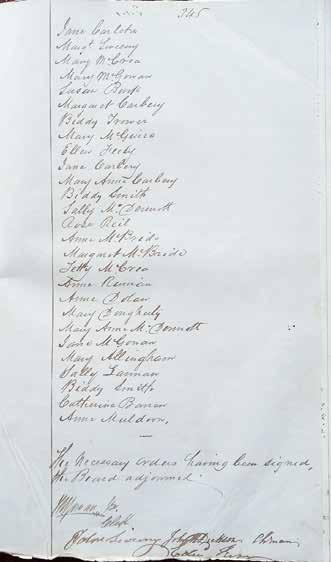
Young women and girls listed for emigration from Ballyshannon Workhouse on the Earl Grey Scheme; Minutes of meeting of Ballyshannon Board of Guardians, 19 August 1848 (Donegal County Archives)
22
In 1848, woollen clothes, bonnets, and luxury goods were still being imported for sale in Letterkenny.29 Despite the crisis of famine, the more affluent citizens of Letterkenny continued unaffected. Some continued to trade without regard to the conflict of interest their role as both supplier and purchaser occupied, while those in their care were punished for stealing food. Yet gradually by 1849, Letterkenny main street felt the effects of the crisis and was described as “broad, sometimes rather ragged looking, always idle-looking, busy only on market days.”30
29 “Just Arrived,” Derry Journal, 3 November 1847: 3.
30 Thomas Carlyle, Reminiscences of my Irish journey in 1849, (New York: Harper & Brothers, 1882) 198.
23
Essays by Dr Hilary McLaughlin-Stonham, Historian in Residence
The Consequences will be fearful: The Great Famine in County Donegal
Inishowen Workhouse in a time of crisis
The role of the workhouse in the period of the Great Famine of 18451851 casts a long shadow extending beyond the buildings themselves. Steeped in an aura of rigid uniformity, workhouses in Donegal were often the last hope and resort of those affected by the Famine. How the Inishowen workhouse coped with the onset of the catastrophe and the worst Famine years is illustrated through the management of deteriorating conditions as growing numbers of destitute and starving men, women and children petitioned for relief. Moreover, Inishowen workhouse highlights the prevailing attitudes of those in authority towards managing the destitute poor while revealing the experiences of those admitted.
The Poor Law system of 1838 established Inishowen Union to represent twenty-one electoral divisions over an area of 248 square miles with a diverse population of approximately 43,000 on farms, in fishing communities and in market towns.1 The Union was overseen by an elected Board of 22 Guardians and reported directly to the Poor Law Commissioners. An additional six ex-officio Guardians served in an advisory capacity due to their office or position of influence. These included landlords such as George Young of Culdaff and John Harvey of Malin Hall, who served at different times as Justice of the Peace (JP), Deputy Lieutenant and High Sherriff of Donegal.2 Captain Thomas Metcalf and Samuel Rankin of Tiernaleague House were also JPs and landlords. The prominent landowner Robert Moore,
1 Irish Census Commissioners. Irish Census report 1841 (Dublin: Alexander Thom, 1843), 306-307.
2 Bernard Burke, History of the Landed Gentry of Great Britain and Ireland (London: Harrison, 1879), 1:750.
24
|
who intermittently acted as Clerk and Chairman, also served on Carndonagh Relief Committees.3 In the Market House of Carndonagh in November 1840 the first Board of Guardians assembled to elect Thomas Doherty as chairman. The first resolutions were the building of a workhouse to accommodate 600 paupers and for a valuation of the Inishowen district for rate payers to support it.4
On 5th of October 1843, the first paupers, two children, were admitted and were soon followed by women and men classed as beggars. They were generally older, ill, widowed and Roman Catholic. Younger people were frequently their dependants, classed as ‘idiots’ or disabled.5 Meals were unimaginative with oatmeal and buttermilk for breakfast and supper and potatoes and buttermilk for dinner. The Infirmary meals added bread and butter, and meat and ale were served at Christmas.6 Paupers had to be respectful to staff and swearing was forbidden. Leaving the workhouse without permission resulted in a one-month suspension. Although the Guardians were criticised for granting leave too liberally, the rigidity often caused paupers to abscond.7
In October 1845 potatoes were still being bought by the workhouse and there was no difficulty with supply. The potato blight was not described as severe in the surrounding areas until 1846. However, the number of younger, healthier paupers entering the workhouse increased that autumn.8 The Commissioners advised the Guardians to subsidise the diet with oatmeal, rice and bread in view of the potato shortages.9 In 1846 the attendance of the Guardians was infrequent and
3 The Londonderry Standard, February 5, 1847, 2.
4 Inishowen Board of Guardians, Minutes 1840-1845, 1-6.
5 Inishowen Board of Guardians, Register of People admitted to and discharged from the Workhouse, 1843-1849, 6-9. For more on the operation of workhouses in Ireland see: Gerard O’Brien, “Workhouse Management in Pre-Famine Ireland,” Proceedings of the Royal Irish Academy. Section C: Archaeology, Celtic Studies, History, Linguistics, Literature 86C (1986): 115-18.
6 Inishowen Board of Guardians, Minutes 1840-1845, 77, 110-12,302.
7 Inishowen Board of Guardians, Minutes 1845-1848, 1-3.
8 John Thompson, Diary of John Norris Thompson, Carndonagh, 121.; Inishowen Board of Guardians, Register 1843-1845, 10.
9 Inishowen Board of Guardians, Minutes 1845-1848, 25.; John Thompson, Diary, 121-126.
25 Essays by Dr Hilary McLaughlin-Stonham, Historian in Residence
The Consequences will be fearful: The Great Famine in County Donegal
when the roof of the workhouse leaked ‘most severely’ the workhouse master blamed their neglect. Yet the principle of dissuading people from workhouse relief continued and Guardians sought out families of workhouse inmates who were charged for their keep. 10 By March of 1846, whole families of various conditions began to be admitted. Sometimes this was women with up to eight children or a husband, wife, and child. The Guardians responded severely to the threat of fever and contamination. When Brigid McGonagle was left at the door afflicted with fever, acting Chairman John Harvey complained that ‘Matron had no means of getting rid of her’.11
In Autumn 1846 ‘the terrible rot’ became obvious in Inishowen and larger groups of people from outlying areas were admitted.
Destitution and starvation were reported with women and children identified as the most vulnerable. Food prices soared and while the workhouse managed to tender for Indian meal and oatmeal, as the Famine years progressed the price of oatmeal soared.12 Initially there was no relief work for women and not enough for the men and this was translated to the workhouse registers as ‘can’t get employment’. To contain infection, a woman was employed to wash and look after the fever patients. Indian meal was added to dinner and the Guardians ordered hundreds of clothes in preparation for worsening conditions.13 This anticipation included cutting meals from three to two, but the Commissioners felt such a reduced diet would be ‘injurious’. The Guardians disregarded this advice and a shortage of bread meant that meals were supplemented with buttermilk, and against medical advice, molasses, as the price of oatmeal rose. Despite fever and shortages in food, the Board resolved to maintain a semblance of normality. Children continued to be educated and surprisingly, female literacy improved.
10 Inishowen Board of Guardians Minutes 1845-1848, 46,49, 73.
11 Inishowen Board of Guardians, Register 1843-1849, 13,14.; Inishowen Board of Guardians, Minutes 1845-1848, 53.
12 John Thompson, Diary, 121-123.; John Canning, “Destitution in the Barony of Ennishowen,” The Londonderry Standard, January 8, 1847, 4.; Inishowen Board of Guardians, Register 1843-1845, 13-14, 17-29.; Inishowen Board of Guardians, Minutes 1845-1848, 99.
13 Inishowen Board of Guardians, Minutes 1845-1848, 101-109, 114-128, 142- 143.
26
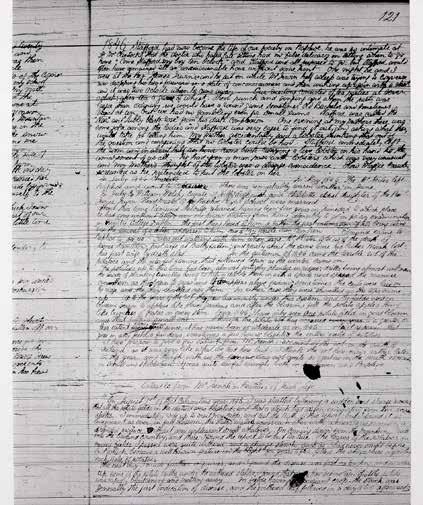
Extract from John Norris Thomson’s diary describing the effects of the Great Famine in the locality, p. 121, MIC 162
(Image Courtesy of Public Record Office of Northern Ireland)
In 1847, the worst year of the Famine, the Commissioners directed the Guardians to increase accommodation by one third.14 As poor rates became more difficult to collect, the rigidity of the workhouse system increased. Sally Shields was discharged for taking extra porridge to her brother’s ward and both were no longer considered as ‘proper objects
14 Ibid, 156-159,174.
27
Essays by Dr Hilary McLaughlin-Stonham, Historian in Residence
The Consequences will be fearful: The Great Famine in County Donegal
for relief’. The same fate befell Grace McLaughlin, her husband and 12-year-old daughter.15 When it became clear that the Board could not meet its accounts, there was a significant decline in the number of paupers admitted and the price of oatmeal crept towards £28 a ton. Private houses were hired as fever cases grew, and plans were drawn for a temporary fever hospital as the Guardians sought to take control of worsening conditions.16 When pauper Nancy McLaughlin feared contagion and removed her children from the infirmary, the Board refused to let her see her children unsupervised and threatened eviction for the whole family.17
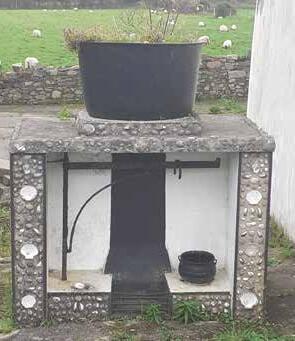
15 Inishowen Board of Guardians, Minutes 1845-1848,190-196; Inishowen Board of Guardians, Register 1843-1849, 19.
16 Inishowen Board of Guardians, Minutes 1845-1848, 200-202. Workhouses in Donegal were among the last to fill up in the country. See: James Grant, “The Great Famine and the Poor Law in Ulster: The Rate-in-Aid Issue of 1849,” Irish Historical Studies 27, no. 105 (1990): 31.
17 Inishowen Board of Guardians, Minutes 1845-1848, 210.
28
Famine Pot at Brachán House, Carndonagh (Image: Hilary McLaughlin-Stonham)
The Guardians continually sought legal action against rate collectors and contractors for insufficient delivery. Anyone showing signs of fever was not to be admitted. Outdoor relief began in 1847 but the wives and children of men recovering from fever were not entitled to relief. 18 Women and children were made further vulnerable because guardians also served as JPs and were privy to local court proceedings. Nine women with their children were discharged when the Carndonagh Petty Sessions court found they had not been abandoned but had left their husbands in order to enter the workhouse.19 By February 1848 the medical officer stated that the maximum capacity of 600 paupers had been reached but that the house could hold 50 more. Clothing was no longer ordered, instead only material, with clothes created in the workhouse. To increase space, the master was ordered to discharge 30 or 40 paupers who were in the workhouse over a month and qualified for outdoor relief.20 Only those who were considered in extreme necessity were to be provisionally admitted. In March 1848 the Guardians were chastised by the Commissioners as neglectful in giving their full attention to the Union.21 Consequently the master was provided with an assistant and potato seeds were planted in the grounds while the food allowance was slightly raised. By October 1848 potatoes were being served again. Outdoor relief was discontinued as numbers within the house fell to 256 from 690 but many continued to appeal for it. Officers’ salaries were also lowered but the Guardians began to invest in the workhouse, ordering the painting of wards. Punishments were sometimes lighter, a supper withdrawn for absences as opposed to discharge. However, in July 1849 while weekly outdoor relief was provided to four people, numbers within the workhouse rose above capacity again.22 By the end of 1849 the price of oatmeal had gradually fallen, and the workhouse emerged from the crisis as death rates fell and paupers stayed shorter periods.
18 Ibid 242-246, 254, 348.
19 Ibid, 254.
20 Ibid, 374-377, 384.
21 Ibid, 374-388,396.
22 Inishowen Board of Guardians, Minutes, 1848-1849, 3- 24,131, 136; “Inishowen Union,” The Londonderry Journal, 20 July 1850; 3.
29 Essays by Dr Hilary McLaughlin-Stonham, Historian in Residence
The Consequences will be fearful: The Great Famine in County Donegal
However, the number residing in the workhouse remained at maximum capacity and would not drop significantly until 1850. Death was a spectre throughout this period, but rates were particularly high in 1847 and in the first six months of 1848. The elderly and young children were particularly vulnerable as workhouse inmates throughout the Famine years.23
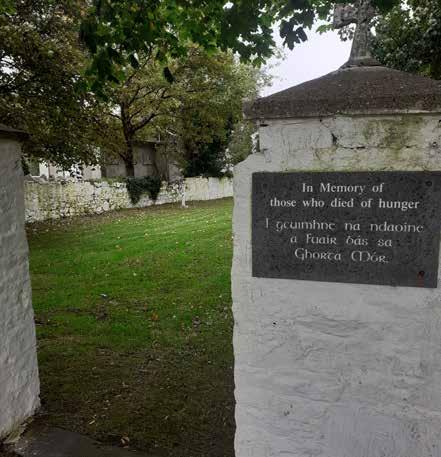
30
23 Inishowen Board of Guardians, Register, 1843-1849, 10-250; Inishowen Board of Guardians, Register of People admitted to and discharged from the Workhouse, 18491859, 1-78.
Famine Graveyard, Carndonagh (Image: Hilary McLaughlin-Stonham)
In 1850, as the Famine began to recede, the Commissioners protested against Guardians withholding food as punishment. The Guardians’ response summed up their attitude going forward into the next decade. “The Commissioners be informed…that the punishment of stopping half the diet of the pauper… has been inflicted on him, without any injury to his health, but the guardians hope to the improvement of his morals.” 24
Although the Inishowen workhouse catered for a population of approximately 43,000 people, it was only overcrowded intermittently during the Famine period. This was due to the strict criteria of admission, harsh discipline, and the willingness of the Guardians to discharge paupers in the most extreme conditions. They often disregarded the Commissioners’ advice on diet, providing the minimal amount for subsistence and punished those that procured more. The Guardians prevented chaos by building temporary accommodation and renting properties and their focus on maintaining pre-Famine regulations had some benefits, especially in the improvement of female literacy. However, these values came at a cost to many, especially the most vulnerable women and their dependants. The prevailing attitudes of those in authority towards managing the destitute poor made the workhouse environment inflexible, unsympathetic and at times, neglectful.
31
in Residence
Essays by Dr Hilary McLaughlin-Stonham, Historian
24 Inishowen Board of Guardians, Minutes 1849-1852, 4.
Emigration: Farewells and new beginnings
The dire conditions of the Great Famine saw emigration from Donegal increase dramatically between 1845 and the early 1850s. It set the pattern for future generations as an opportunity for a new life and an escape from poverty. For some, the decision to leave would be made hastily when conditions worsened. For others, it would take a calamity to push rather than lead them to a life away from Donegal shores. Letters home offered mixed emotions of a better life tinged with regret, while official and newspaper reports would reveal the full extent of what these perilous journeys to a new life entailed as well as the experiences of the new immigrants.
The decision to leave Donegal for most emigrants was not an easy one. It meant leaving the natural networks of support, family, neighbours, and friends behind, to venture to unfamiliar territories that offered, at times, a hostile welcome. For most, emigration was a choice, in that there were other options, but these included reliance on often sparse work schemes, the workhouse or unmanageable debt and threat of eviction. Some took advantage of assisted passenger schemes while others left less voluntarily, through enforced emigration schemes by landlords using famine conditions to clear subtenants off their land. Destinations included Australia, Canada, and the United States. The William McCorkell & Co. shipping lines, alongside the ships of J & J Cooke sailed direct from Derry, a manageable distance from Inishowen and the Northwest. Farewells often took place at landmarks such as the ‘Bridge of Tears’ in Dunfanaghy, features which became iconic in the famine landscape. People from south and southwest Donegal at times emigrated from Sligo or in many cases travelled first to Glasgow or Liverpool and then took a ship to North America or
32 The Consequences will be fearful: The Great Famine in County Donegal |
Australia. Many people, however, were too poor and ravished by famine to make the onward journey across the Atlantic and were instead often forced to enter a workhouse in Britain.1
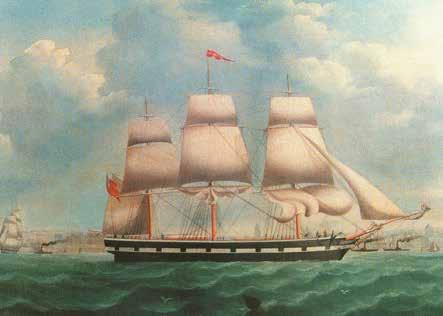
The Mohongo passenger ship, launched in 1851, brought emigrants from Derry to Canada and America
(© Derry City and Strabane District Council Museum & Archive Collections)
Landlords also at times forcefully encouraged emigration when they could not or were unwilling to support famine-stricken tenants such as those on Arranmore Island. Promising a ship to take them to North America, subtenants were evicted off the island in 1851 when they could not produce any evidence of tenancy. Many would end up in
1 Deirdre M. Mageean, “Emigration from Irish Ports,” Journal of American Ethnic History 13, no. 1 (1993): 6-14.; Catherine Cox, Hilary Marland, and Sarah York, “Emaciated, Exhausted, and Excited: The Bodies and Minds of the Irish in Late Nineteenth-Century Lancashire Asylums,” Journal of Social History 46, no. 2 (2012): 501.
33
Essays by Dr Hilary McLaughlin-Stonham, Historian in Residence
The Consequences will be fearful: The Great Famine in County Donegal
Canada on ships such as the Countess of Arran which arrived from Donegal in Quebec with 172 steerage passengers in 1851.2
In 1847 the British Secretary to the Colonies, Earl Grey, sanctioned the free passage of families who could provide sufficient clothes for themselves, to join their former convict husbands in Australia. It offered escape for women like Ellen Doherty who was remarkable in her determination to emigrate. Setting out with her children, Brigid, 14 and Daniel, 11, they walked from Buncrana to Dublin, a 250 km journey in September 1849. They missed their boat, and clearly exhausted, Ellen refused the second boat but eventually boarded the St Vincent in 1851.3 Ellen was among the four wives and 16 children who were part of the convict family applications for Donegal between 1847 and 1851. Only half were among the arrivals.4
Other assisted passengers included destitute girls from workhouses around the county such as Ballyshannon and Letterkenny. Under loans sanctioned by the Colonial Land and Emigration Commission, whole families were also facilitated to emigrate by Union Boards of Guardians, especially if they had been in the workhouse for extended periods.5 Reports from Australian officials showed complaints as to the ‘quality’ of the immigrants sent out from Ireland and in particular the orphans. They were described as ‘being of the worst characters and are stated by the immigration Agent to have turned out ill in the
2 The Society of Friends, Transactions of the Central Relief Committee of the Society of Friends During the Famine in Ireland 1846 and 1847 (Hodges and Smith: Dublin, 1852) 150.; “Port of Quebec, Arrived June 4,” The Quebec Mercury, June 5, 1851, 3.; Newspapers often recorded cabin passengers’ details but only provided numbers of steerage passengers; The Dance of the Fishing Boats/Island Life, Donegal Museum Exhibition 2020.
3 NSW Assisted Immigrant Passenger Lists, 1828-1896. Archives Australia.; Dispatches, Emigration commissioners to Colonial Office, 10 January 1851.
4 Richard Reid, “‘The famine is pressing each day more heavily upon them’: The emigration of Irish convict families to New South Wales, 1848-1852,” in Poor Australian Immigrants in the Nineteenth Century, ed. Eric Richards (Canberra: Australia National University, 1991) 95.
5 Robin Haines, “Indigent Misfits or Shrewd Operators? Government-Assisted Emigrants from the United Kingdom to Australia, 1831-1860,” Population Studies 48, no. 2 (1994): 223–47.
34
colony.’ The number of assisted immigrants who went from Donegal to Sydney and Port Phillip in New South Wales in 1848 was 66, the journey taking an average of 107 days. Their condition on arrival was often poor and children were poorly clothed. As a result, prejudice began to shadow the emigrants. Reports grew of a ‘disinclination’ to employ Irish immigrants if English or Scottish labour was available. The types of jobs available varied but were usually labour intensive such as agricultural labourers and house servants in particular. Occupations not in demand included clerks, ladies’ maids and artists. 6
Canada also offered opportunities and when the Marchioness of Clydesdale left Derry for Canada in 1847, of the 380 passengers, 242 were from Donegal. This included the large Timeny family from Ballintra in south Donegal and the smaller Faulkner family from Quigley’s Point in Inishowen. It was in places such as these in 1847 that emigrants abandoned their farms and homes to walk to the departing ships in Derry, often with no prospect of returning.7 Emigrants who arrived in Saint John, the New Brunswick port in Canada, often faced further difficulties. Donegal patients were included in the Emigrant Hospital admissions in 1847-8, among them forty-year-old John Blaney who arrived from Derry on the Portland in August 1847. He was admitted with dysentery and fever. Of those laid off from work on the Canadian railways due to lack of progress in 1848, many, already weakened by the voyage, found themselves with no means of supporting themselves.8
6 “Immigration Papers Relative to the Australian Colonies: In continuation of House of Commons Papers,” no. 593, July 1849, vol. 2 (London: W. Clowes & Sons, 1850) 121, 66, 55.; “Immigration Papers Relative to the Australian Colonies,” July 1852, vol. 34 (London: George Edward Eyre & William Spottiswoode, 1852) 124-131.
7 For passenger lists out of Derry in 1847-48 see: Brian Mitchell, Irish Passenger Lists 18471871, (Baltimore, Genealogical Publishing Co., 1988).; Maghtochair, Inishowen: Its History, Traditions & Antiquities, (Londonderry: Londonderry Journal: 1867) 174.
8 List of Patients at Emigrants’ Hospital in Saint John; 1847-1849.; Correspondence Relating to the ship “Star” and the Railway Labour Immigrants; 1848-1849, 1853.
35
by Dr Hilary McLaughlin-Stonham, Historian in Residence
Essays
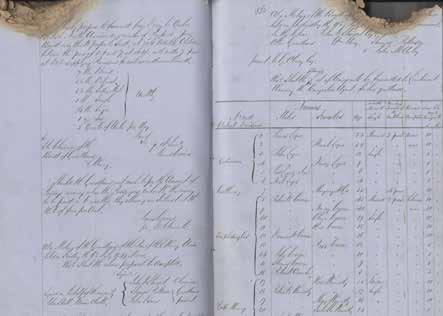
Families listed for emigration from Letterkenny workhouse, Minutes of Meeting of Letterkenny Board of Guardians, 6 July 1849 (Donegal County Archives)
American and Canadian voyages were perilous. When the Virginius completed the voyage from Liverpool to Grosse Isle, Quebec, in 1847, 158 of the 476 Irish passengers were dead, and a further 109 died at the quarantine centre.9 Emigrants from Donegal did not have to travel far to experience dreadful conditions. The Londonderry Sentinel reported that 72 people were discovered to have suffocated on an overcrowded paddle steamer, the Londonderry, travelling from Sligo, when it took shelter during a storm in Derry in 1848. Accounts from the inquest show that there was no note taken of how many were onboard as children were not counted.10 Emigration Commissioners described horrific conditions on ships to Australia, particularly on the Reliance in 1850. Reports show that when fever broke out, the healthy,
9 Phillip Harling, “Assisted Emigration and the Moral Dilemmas of the Mid-Victorian Imperial State,” The Historical Journal 59, no. 4 (2016): 1027-8.
10 “The Awful Catastrophe Onboard The “Londonderry” Steamer,” The Londonderry Sentinel, December 7, 1847, 2-3.
36
The Consequences will be fearful: The Great Famine in County Donegal
sick, and dead were not separated. When a passenger died at the mess table, others were obliged to eat their meals in the surrounding space. A single woman who ‘mixed’ with the sailors had her hair cut off, was handcuffed and put in the dark, ill ventilated hospital.11 Yet ships for Quebec, New York, Philadelphia, Glasgow, and Liverpool filled the pages of the Londonderry Sentinel offering bread, oatmeal or flour daily on the passage.12
Despite the hardships of raising funds to emigrate, and the poor travel conditions, emigrants often experienced mixed reactions to their arrival on foreign shores. Only 6-8% of all Famine emigrants were assisted by Poor Law Unions, private charitable organisations and landlords. Most found ways to fund their passage and once employed, sent passage money or prepaid tickets to relatives with both positive and negative accounts of the emigration experience.13 William Dever wrote to his family in Donegal in 1848 from America,
‘But most of the Irish come out poor, unable to purchase farms. They work digging quarries, carrying brick and mortar in scorching sun, up to the fourth stories of houses; in winter nothing to do, all their money spent. They are despised and kicked about. Many write home they are happy and wealthy’…14
During the worst years of the Famine, 1846-1849, 12,300 Donegal people emigrated through the port of New York. Between 1851-54 another 16,500 would follow. The Irish Emigrant Society of New York set up a savings bank to make it easier for Irish migrants to send remittances homeward and emigration became a chain.15
11 Dispatches, Emigration Commissioners to Colonial Office, 10 January 1851.
12 The Londonderry Sentinel, March 6, 1847, 3.
13 Harling, “Assisted Emigration,” 1031.
14 Dever Kerby Miller and Paul Wagner, Out of Ireland: The Story of Irish Emigration to America (Washington, D.C.: Elliot & Clark, 1998), 39.
15 Richard J. Purcell, “The Irish Emigrant Society of New York,” Studies: An Irish Quarterly Review 27, no. 108 (1938): 597.; Anbinder, Tyler, and Hope McCaffrey, “Which Irish Men and Women Immigrated to the United States during the Great Famine Migration of 184654?” Irish Historical Studies 39, no. 156 (2015): 631.
37
Historian in Residence
Essays by Dr Hilary McLaughlin-Stonham,
The Consequences will be fearful: The Great Famine in County Donegal
Letters home from emigrants show that they remained concerned with land and inheritance despite making new homes abroad. They anxiously followed accounts of the Famine and were aware of its progress in Donegal.16 Emigrants from Carndonagh, such as Rosetta Kearney, detailed the opportunities their new homelands offered and the increased wages they could make, to the extent of paying off debts at home. Despite the change in lifestyle, the letters clearly articulate homesickness and a need for news, ‘This is a great country and its freedom I adore but dearer to me is the home of my girlhood.’17

Letter from Rosetta Kearney, Nashville, Tennessee, to Robert Moore, Carndonagh, Co. Donegal, 24 January 1856, T2799/1/3
(Image Courtesy of Public Record Office of Northern Ireland)
However, letters did not always make it home and the Boston Pilot Newspaper was one of many filled with advertisements from family members seeking Donegal people who never returned home. An advertisement was placed for Hannah Galaugher of Stranorlar by
16 Letter, Hubbard, Ohio, to Mrs. Margaret White, County Donegal.; Letter, Pennsylvania to Robert Taylor: The Taylors of Shanrod Co Down, Letters from America.
17 Papers of Robert Moore, Carndonagh, County Donegal, 1854-1936.
38
her sister and brother after she emigrated to Illinois in 1851. By 1852 they had no word of her whereabouts. Emigrants could also willingly disappear in the United States. Margaret Ann Mulgrew from Letterkenny left her husband when she reached St Louis in 1852. He offered a reward of $5 for her location in 1865, ‘dead or alive’.18 Charities arose out of the influx of immigrants. The Donegal Relief Fund was set up in 1858 to send for relatives to join family in New South Wales. As emigration continued after the Famine, smaller ports such as that in Moville would become a major port of embarkation and Donegal would rival Cork harbour as a departure point for immigration to Canada.
Emigration around the world offered work and a quality of life that were otherwise beyond the reach of families and individuals in Donegal during the Famine period. The journeys were not without risk, and often people never returned, or they disappeared entirely. However, it furthered opportunities not just for those who went abroad, but also for family at home in the form of money or a boat ticket. For family members left behind, it created a chain of emigration and a way out of poverty and destitution.
18 Boston Pilot Newspaper Wanted Advertisements. For more on those who willingly disappeared see: B. Emer O’ Keeffe, ed., The Search for Missing Friends: Irish Immigrant Advertisements Placed in the Boston Pilot, VII (Boston: New England Historical Genealogical Society, 1999), xii-xviii.
39
by
Hilary McLaughlin-Stonham, Historian in Residence
Essays
Dr
References
Donegal County Council Archives and Museum Resources
Annual Report of the Commissioners for Administrating the Laws for Relief of the Poor in Ireland (Alexander Thom: Dublin, 1843). Donegal County Archives Collection, PL/1/3
Annual Report of the Commissioners for Administrating the Laws for Relief of the Poor in Ireland (Alexander Thom: Dublin, 1850). Donegal County Archives Collection, PL/1/4.
Inishowen Board of Guardians. Minutes 1840-1845. Donegal County Archives Collection, BG/ 97/1/1.
Inishowen Board of Guardians. Minutes 1845-1848. Donegal County Archives Collection, BG/ 97/1/2.
Inishowen Board of Guardians. Minutes 1848-1849. Donegal County Archives Collection, BG/ 97/1/3.
Inishowen Board of Guardians. Minutes 1849-1852. Donegal County Archives Collection, BG/ 97/1/4.
Inishowen Board of Guardians. Register of People admitted to and discharged from the Workhouse, 1843-1849. Donegal County Archives Collection, BG/ 97/3/1.
Inishowen Board of Guardians. Register of People admitted to and discharged from the Workhouse, 1849-1859. Donegal County Archives Collection, BG/ 97/3/2.
Letterkenny Board of Guardians (1846). Minutes 1841-1846. Donegal County Archives Collection, BG109/1/1.
40
|
The Consequences will be fearful: The Great Famine in County Donegal
Letterkenny Board of Guardians (1847). Minutes 1847-1848. Donegal County Archives Collection, BG109/1/2.
Letterkenny Board of Guardians (1848) Minutes 1848-1850. Donegal County Archives Collection, BG109/1/3.
Letterkenny Relief Committee (1847), Relief Committee Minutes and Rough Minutes Book, 1847. Donegal County Archives Collection, BG 109/2/1.
Murray Scarborough Receivers 7th Account Book, 1852. Murray Stewart Collection. Donegal County Archives Collection, P/2/2/2.
Milford Board of Guardians (1847). Report of Visiting Committee 1846-1912. Donegal County Archives Collection, BG/119/3/1.
Milford Board of Guardians (1848). Minutes 1840-1923. Donegal County Archives Collection, BG/119/1/1.
Milford Board of Guardians (1849). Minutes 1840-1923. Donegal County Archives Collection, BG/119/1/4.
The Dance of the Fishing Boats/Island Life, Donegal Museum Exhibition 2020. Available at: https://www.donegalcoco.ie/media/ donegalcountyc/museum/Arranmore%20exhibition%202020.pdf [Accessed 18/06/2023].
The Trustees of Horatio Granville Steward Murray Esq. 1846. Murray Stewart South Donegal estate survey and rentals, 1749, 1846 – 1905. Donegal County Archives Collection, P/2/2/1.
41
Essays by Dr Hilary McLaughlin-Stonham, Historian in Residence
The Consequences will be fearful: The Great Famine in County Donegal
National Archives
Hayden, Charles. Letter, Famine Relief Commission, 25 October 1845. National Archives Chief Secretary’s Office Registered Papers, Z series: RLFC2/Z14512.
Ireland Valuation Office Field Book 4. County Donegal. National Archives: 4.2321.
Prior, George. Letter, Famine Relief Commission: Incoming Letters, 5 August 1846. National Archives Incoming Letters: RLFC3/1/5172.
Walker, J. C. Letter, Famine Relief Commission: Incoming Letters, 15 October 1846. National Archives Incoming Letters: RLFC3/2/7/28.
Wilson, Matthew. Letter, Famine Relief Commission, 16 September 1846. National Archives Incoming Letters: RLFC3/2/7/27.
Young, Brook. Letter, Famine Relief Commission, 22 February 1847. National Archives Baronial sub-series: RLFC/3/2/7/19.
PRONI Archives
Thompson, John. Diary of John Norris Thompson, Carndonagh. Public Record Office Northern Ireland, MIC. 162.
Papers of Robert Moore, Carndonagh, County Donegal, 1854-1936, PRONI T2799/1.
MCMS Archives
Letter, Hubbard, Ohio, to Mrs. Margaret White, County Donegal. Mellon Centre for Migration Studies. IED 9310391.
Letter, Pennsylvania to Robert Taylor: The Taylors of Shanrod Co Down, Letters from America. Mellon Centre for Migration Studies. IED 0701102.
42
Digitised Archives
Annual Report of the Commissioners for Administrating the Laws for Relief of the Poor in Ireland (Alexander Thom: Dublin, 1848). Available at: https://babel.hathitrust.org/cgi/ pt?id=uiug.30112042672219&view=1up&seq=7 [Accessed 18/03/2023].
Boston Pilot Newspaper Wanted Advertisements. Available at: https:// search.findmypast.ie/search-world-records/boston-pilot-newspaperinformation-wanted-ads [Accessed 20/07/2023].
Correspondence Relating to the ship “Star” and the Railway Labour Immigrants, 1848-1849, 1853. Provincial Secretary: Immigration Records, The New Brunswick Provincial Archives RS555. Available at: https://archives.gnb.ca/Irish/Databases/ImmigrationRecords/ [Accessed 18/03/2023].
Department of Industry and Commerce. Population of Saorstát Éireann from 1821 to 1936. (Dublin: Stationary Office, 1938), 6. Available at:
https://www.cso.ie/en/census/censusvolumes1926to1991/ historicalreports/census1936reports/census1936volume1/ [Accessed 18/03/2023].
Dispatches, Emigration Commissioners to Colonial Office, 10 January 1851. CO 201/3 AJCP National Library of Australia. Available at: https://catalogue.nla.gov.au/ search?q=Emigration+Commissioners+to+Colonial+Office [Accessed 19/06/2023].
Irish Census Commissioners. Irish Census report 1841. (Dublin: Alexander Thom, 1843), 306-314. Available at: https://www.cso.ie/en/ census/censusreports1821-2006/ [Accessed 18/03/2023].
Irish Famine Memorial Sydney. Orphan Database. Available at: https:// irishfaminememorial.org/orphans/database/ [Accessed 18/03/2023].
43
Essays by Dr Hilary McLaughlin-Stonham, Historian in Residence
The Consequences will be fearful: The Great Famine in County Donegal
Library and Archives Canada: Immigrants at Grosse-Ile Quarantine Station, 1832-1937. Available at: https://www.bac-lac.gc.ca/eng/ discover/immigration/immigration-records/immigrants-grosseile-1832-1937/Pages/list.aspx?k=Donegal& [Accessed 18/03/2023].
List of Patients at Emigrants Hospital in Saint John; 1847-1849, Provincial Secretary: Immigration Records, The New Brunswick Provincial Archives RS555. Available at: https://archives.gnb.ca/Irish/ Databases/ImmigrationRecords/ [Accessed 18/03/2023].
Liverpool Workhouse admissions November 1846-March 1848. Liverpool Records Office: May 5th 1847. Available at: https://www.findmypst.ie [Accessed 18/03/2023].
“Immigration Papers Relative to the Australian Colonies: In continuation of House of Commons Papers no. 593,” July 1849. Parliamentary Papers, 1849 vol.2. London: W. Clowes & Sons, 1850. Available at: https://babel.hathitrust.org/cgi/ pt?id=chi.21720185&seq=9&q1=104+days [Accessed 19/06/2023].
“Immigration Papers Relative to the Australian Colonies”Parliamentary Papers, 1852 vol 34. London: George Edward Eyre & William Spottiswoode, 1852. Available at: https://babel.hathitrust.org/cgi/ pt?id=chi.21720185&seq=7&q1=104+days [Accessed 19/06/2023].
New South Wales, Australia, NSW Assisted Immigrant Passenger Lists, 1828-1896. Available at: https://www.archives.com Accessed 19/06/2023].
44
Newspapers
“Another Step Against Property and Order in Ireland” Dublin Evening Mail, 3 December 1849.
Canning, John. “Destitution in the Barony of Ennishowen.” The Londonderry Standard, January 8, 1847.
“Distress in Ramelton, Letterkenny.” Londonderry Sentinel, 19 December 1846.
“Dreadful Murder” The Londonderry Journal, 27 December 1848.
“Fairs in Ulster for the Current Week,” The Londonderry Journal, 10 April 1838.
“Inishowen Union,” The Londonderry Journal, 20 July 1850.
“Just Arrived.” The Londonderry Journal, 3 November 1847.
“Letterkenny Union.” Londonderry Sentinel, 6 January 1849.
“Port of Quebec, Arrived June 4.” The Quebec Mercury, June 5, 1851.
“The Awful Catastrophe Onboard The “Londonderry” Steamer.”
Londonderry Sentinel, December 7, 1847.
Londonderry Sentinel, 6 March 1847.
Londonderry Standard, February 5, 1847.
“Wanted.” The Londonderry Journal, July 21, 1840.
45
in Residence
Essays by Dr Hilary McLaughlin-Stonham, Historian
The Consequences will be fearful: The Great Famine in County Donegal
Period Publications
Burke, Bernard. History of the Landed Gentry of Great Britain and Ireland. 2 vols. London: Harrison, 1879.
Campbell Foster, Thomas. Letters on the Condition of the People of Ireland. London: Chapman & Hall, 1846.
Carlyle, Thomas. Reminiscences of my Irish journey in 1849. New York: Harper & Brothers, 1882.
Elizabeth, Charlotte. Letters from Ireland MDCCCXXXVII. New York: John S. Taylor, 1843.
Inglis, Henry D. A Journey Throughout Ireland during the Spring, Summer, and Autumn of 1834. London: Whittaker & Co., 1838.
Lewis, Samuel. A Topographical Dictionary of Ireland. London: Lewis & Co., 1837.
Maghtochair. Inishowen: Its History, Traditions & Antiquities. Londonderry: Londonderry Journal: 1867.
Maguire, Canon. Letterkenny Past and Present. Letterkenny: Old Seminary, 1917.
Nicholson, Asenath H. Annals of the Famine in Ireland, in 1847, 1848, and 1849. French: New York, 1851.
The Society of Friends. Transactions of the Central Relief Committee of the Society of Friends During the Famine in Ireland 1846 and 1847. Hodges and Smith: Dublin, 1852.
46
Further Reading
Beattie, Sean. Donegal in Transition: The Impact of the Congested Districts Board. Irish Academic Press: Kildare, 2013.
Cox, Catherine, Marland, Hilary and York, Sarah. “Emaciated, Exhausted, and Excited: The Bodies and Minds of the Irish in Late Nineteenth-Century Lancashire Asylums.” Journal of Social History 46, no. 2 (2012): 500–524.
Grant, James. “The Great Famine and the Poor Law in Ulster: The Rate-in-Aid Issue of 1849.” Irish Historical Studies 27, no. 105 (1990): 30–47.
Haines, Robin. “Indigent Misfits or Shrewd Operators? GovernmentAssisted Emigrants from the United Kingdom to Australia, 18311860.” Population Studies 48, no. 2 (1994): 223–47.
Harling, Phillip. “Assisted Emigration and the Moral Dilemmas of the Mid-Victorian Imperial State.” The Historical Journal 59, no. 4 (2016): 1027–49.
Kent, J. P. “On the Decline of Marriage in Rural Ireland 18511911: The Role of Ecological Constraints and/or Developing Philopatry.” Population and Environment 23, no. 6 (2002): 525–40.
Lysaght, Patricia. “Perspectives on Women during the Great Irish Famine from the Oral Tradition.” Béaloideas 64/65 (1996): 63–130.
Mageean, Deirdre M. “Emigration from Irish Ports.” Journal of American Ethnic History 13, no. 1 (1993): 6–30.
Matheson, Robert E. “The housing of the people of Ireland during the period 1841-1901” Journal of the Statistical and Social Inquiry Society of Ireland 11, no 83 (1902/1903): 196-212.
47
by Dr Hilary McLaughlin-Stonham, Historian in Residence
Essays
The Consequences will be fearful: The Great Famine in County Donegal
Miller, Dever Kerby and Paul Wagner. Out of Ireland: The Story of Irish Emigration to America. Washington, D.C.: Elliot & Clark, 1998.
Mitchell, Brian. Irish Passenger Lists 1847-1871. Baltimore, Genealogical Publishing Co., 1988.
Murray, A. C. “Agrarian Violence and Nationalism in Nineteenth Century Ireland: the Myth of Ribbonism.” Irish Economic and Social History. 13, 1986: 56–73.
O’Brien, Gerard. “Workhouse Management in Pre-Famine Ireland.” Proceedings of the Royal Irish Academy. Section C: Archaeology, Celtic Studies, History, Linguistics, Literature 86C (1986): 113–34.
O’ Gráda, Cormac. The Great Irish Famine. Cambridge: Cambridge University Press, 1995.
O’ Gráda, Cormac. “The Population of Ireland 1700-1900: A Survey.” Annales de Démographie Historique, (1979): 281-299.
O’ Keeffe, B. Emer., ed., The Search for Missing Friends: Irish Immigrant Advertisements Placed in the Boston Pilot, VII. Boston: New England Historical Genealogical Society, 1999.
Purcell, Richard J. “The Irish Emigrant Society of New York.” Studies: An Irish Quarterly Review 27, no. 108 (1938): 583–99.
Reid, Richard. “‘The famine is pressing each day more heavily upon them’: The emigration of Irish convict families to New South Wales, 1848-1852.” in Poor Australian Immigrants in the Nineteenth Century, edited by Eric Richards, 69-96. Canberra: Australia National University, 1991.
Tyler, Anbinder, and McCaffrey, Hope. “Which Irish Men and Women Immigrated to the United States during the Great Famine Migration of 1846-54?” Irish Historical Studies 39, no. 156 (2015): 620-42
48

49
Essays by Dr Hilary McLaughlin-Stonham, Historian in Residence
Ballyshannon Board of Guardians discuss burials during the Famine, 5 June 1847 (Donegal County Archives)
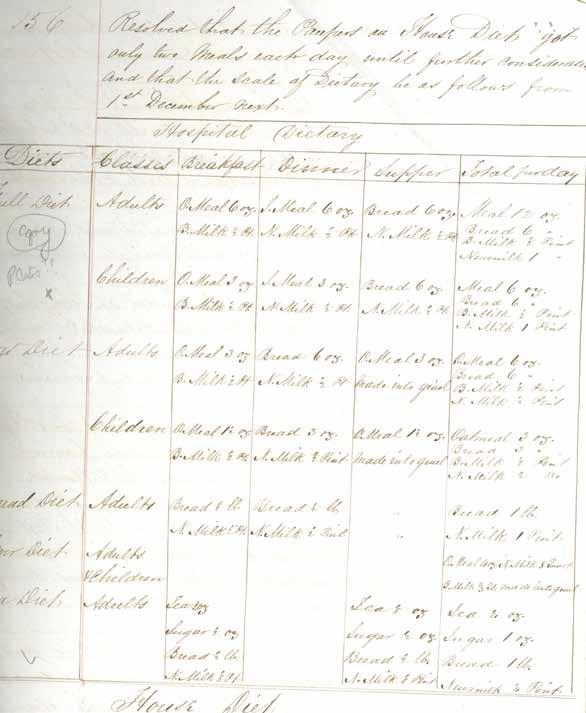


Músaem Chontae Dhún na nGall Donegal County Museum




















